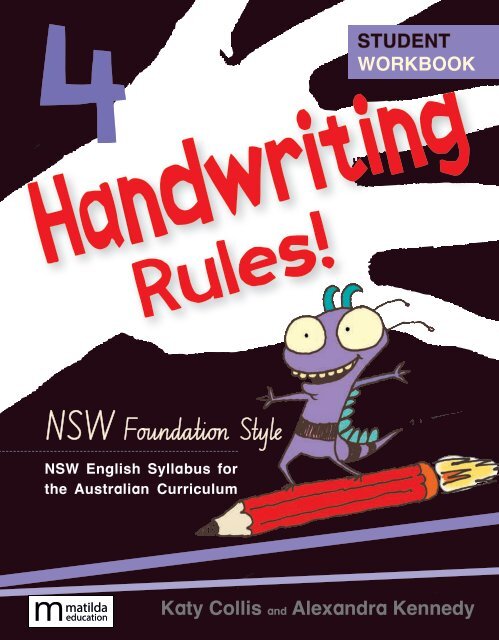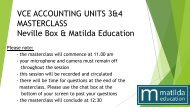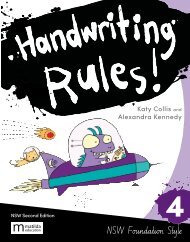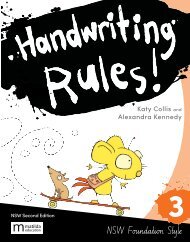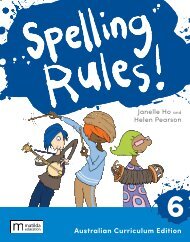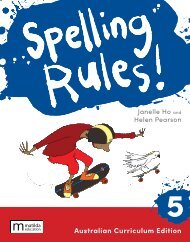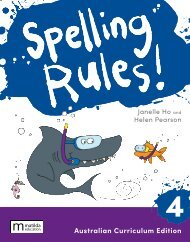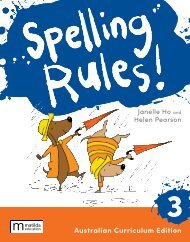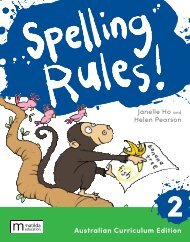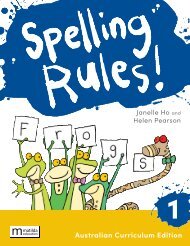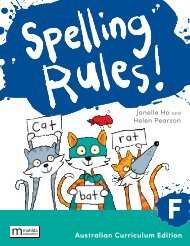Handwriting Rules NSW 4 Student Book sample/look inside
Create successful ePaper yourself
Turn your PDF publications into a flip-book with our unique Google optimized e-Paper software.
H ndwriting<br />
<strong>Rules</strong>!<br />
STUDENT<br />
WORKBOOK<br />
<strong>NSW</strong> Foundation Style<br />
<strong>NSW</strong> English Syllabus for<br />
the Australian Curriculum<br />
Katy Collis and Alexandra Kennedy
Contents<br />
Review: Printing<br />
Lower-case and capital letters......................................2<br />
Numerals and punctuation.............................................3<br />
Labelling diagrams.........................................................4<br />
Review: Diagonal joins<br />
From i, u, m, n, a, c, e, t, d, h, k, l<br />
to body letters including e.............................................5<br />
To head and body letters.............................................. 6<br />
From q and z ..................................................................7<br />
Review: Drop-in joins<br />
To a, c, d, g, o, q.............................................................9<br />
Review: Horizontal joins<br />
From o, r, v, w, x............................................................10<br />
To anticlockwise letters c, a, d, o, g............................11<br />
To head and body letters.............................................12<br />
Review: Joins to and from f<br />
To f ...............................................................................14<br />
From f............................................................................15<br />
Review: Letters that don’t join<br />
From b, g, j, p, s, y........................................................16<br />
New joins<br />
Horizontal to e .............................................................17<br />
Horizontal and diagonal joins to x...............................20<br />
Horizontal joins to s......................................................22<br />
Diagonal joins to s........................................................24<br />
Consolidation ..............................................................26<br />
New guidelines<br />
Writing without head and tail guidelines.....................49<br />
Introducing speed loops<br />
Fluency joins from b, p and s ......................................54<br />
Speed loops to head and body letters b, h, k and l....56<br />
Speed loops from tail letters........................................57<br />
Speed loops to and from f...........................................58<br />
Signatures.....................................................................60<br />
Autographs...................................................................61<br />
Assessment<br />
Progressive speed and fluency trials .........................62<br />
Progressive self-assessment.......................................64<br />
Notes for teachers and parents.......... <strong>inside</strong> back cover<br />
Can others easily read my writing?............. back cover<br />
Pause a moment............................................ back cover<br />
22<br />
Page Page Features<br />
Helpful tips.<br />
New joins: Horizontal joins to s<br />
retrace<br />
o o o o<br />
Extend the exit hook<br />
over the top of the s . . .<br />
Trace then write.<br />
To write faster, you can join s from letters that finish at the top<br />
body line. Make a horizontal join and then retrace the top of the s.<br />
o o o o o o o o o o o o o o o o o o o o o o o o o o o o o o o o o o o o o o o o o o o o o o o o o o o o o o o o<br />
f f f f f f f f f f f f f f f f f f f f f f f f f f f f f f f f f f f f f f f f f f f f f f f f f f f f f f f f f f f f f f f f f f f f f f f f f f f f f f f f f f f f f f f f f f f f f f f f f f f f f f f f f f f f f f f f f f f f f f f f f f f f f f f f f f f f f f f<br />
r r r r r r r r r r r r r r r r r r r r r r r r r r r r r r r r r r r r r r r r r r r r r r r r r r r r r r r r<br />
Trace then write these adverbs.<br />
posibl posibl posibl posibl posibl posibl posibl posibl posibl posibl posibl posibl posibl posibl positive<br />
el el el l l l l l l loosel loosel loosel loosel loosel loosel loosel loosel loosel mostl mostl mostl mostl mostl mostl mostl mostl mostl crosl crosl crosl crosl crosl crosl crosl crosl crosl<br />
Trace then write the sentences.<br />
then retrace back around.<br />
“I’m positive<br />
e i i i i i i i i i i i i coul coul coul coul coul coul coul coul coul coul coul coul posibl posibl posibl posibl posibl posibl posibl posibl posibl posibl posibl posibl rai rai rai rai rai rai rai rai rai rai rai rai ,” ” sai sai sai sai sai sai sai Sa Sa Sa Sa Sa Sa Sa .<br />
Th Th Th Th Th Th Th Th Th oaf oaf oaf oaf oaf oaf oaf oaf oaf wore scarf scarf scarf scarf scarf scarf scarf scarf scarf scarf scarf scarf an an an an an an an an an an an an briefs.<br />
Self-assessment Tick any joins to s that are excellent.<br />
Underline any joins that you could improve.<br />
<strong>Handwriting</strong>: horizontal joins to s. Punctuation: sentence punctuation, speech marks, proper noun (Sam). Grammar: how adverbs ending<br />
in -ly, modality (possibly). Spelling and vocabulary: suffi x -ly (possibly, positively, loosely, mostly, crossly).<br />
A variety of practice<br />
activities. These<br />
provide an English<br />
curriculum context<br />
for handwriting,<br />
to give it meaning<br />
and make it fun and<br />
motivating for Year 4<br />
students.<br />
For the teacher,<br />
links to grammar,<br />
punctuation, spelling<br />
and vocabulary, and<br />
literary elements.<br />
Clear instructions to teach or<br />
review each join.<br />
38<br />
Consolidation: all joins<br />
Remember to keep<br />
your letter shape, size,<br />
slope and spacing<br />
consistent.<br />
Trace then write the thinking verbs.<br />
Link to animation<br />
showing correct<br />
join formation.<br />
(Download a QR<br />
code reader from<br />
the App Store.)<br />
Self-assessment<br />
feature to<br />
encourage<br />
students to take<br />
responsibility<br />
for their own<br />
progress.<br />
ho ho ho ho ho ho ho ho ho e ho ho ho ho ho ho ho ho ho e e e e e e e e e wis<br />
he he he he he he wondere wondere wondere wondere wondere wondere wondere wondere wondere wondere wondere wondere<br />
Trace then write.<br />
This edition published in 2021 by<br />
Humorous illustrations<br />
to reinforce concepts.<br />
believe<br />
e e e<br />
<br />
Thomas sa sa sa sa sa sa sa sa sa sa sa sa sa sa i i i i i i i i i i i i i i th th th th th th th th th th th th th th docto’s docto’s docto’s docto’s docto’s docto’s docto’s docto’s docto’s docto’s docto’s docto’s docto’s docto’s waitin waitin waitin waitin waitin waitin waitin waitin waitin waitin waitin waitin waitin waitin roo roo roo roo roo roo roo roo roo roo roo roo roo roo , tryin tryin tryin tryin tryin tryin tryin tryin tryin no no no no no no no no no<br />
t t t t t t t t t pani pani pani pani pani pani pani pani pani abou abou abou abou abou abou abou abou abou his ar ar ar ar ar ar ar . It wa wa<br />
wa<br />
wa<br />
n’t <strong>look</strong>in <strong>look</strong>in <strong>look</strong>in <strong>look</strong>in <strong>look</strong>in <strong>look</strong>in <strong>look</strong>in <strong>look</strong>in <strong>look</strong>in goo goo goo goo goo goo goo goo goo .<br />
A red stai stai stai stai stai stai stai stai stai stai stai stai<br />
was seepin seepin seepin seepin seepin seepin seepin seepin seepin seepin seepin seepin through th th th th th th th th th th th th bandage .<br />
Oops, though though though though though though though though though Thomas. I thin thin thin thin thin thin thin thin thin thin thin thin thin thin thin I us<br />
e e e e e e e e e to to to to to to to to to muc muc muc muc muc muc muc muc muc ja ja ja ja ja ja ja ja ja .<br />
Self-assessment Cross out the words that don’t apply.<br />
I need to work on my letter shapes, slope, spacing, size, tails.<br />
<strong>Handwriting</strong>: all joins. Grammar: thinking verbs (thought, think), apostrophe for possession (doctor’s), proper noun (Thomas). Spelling and<br />
vocabulary: apostrophes for contraction (wasn’t), homophone (too/to/two). Literary elements: third person narrative, point of view, quote<br />
from Doubting Thomas, by Morris Gleitzman (2006).<br />
Matilda Education Australia, an imprint<br />
of Meanwhile Education Pty Ltd<br />
Level 1/274 Brunswick St<br />
Fitzroy, Victoria Australia 3065<br />
T: 1300 277 235<br />
E: customersupport@matildaed.com.au<br />
www.matildaeducation.com.au<br />
First edition published in 2014 by<br />
Macmillan Science and Education Australia Pty Ltd<br />
Copyright © Katy Collis, Alexandra Kennedy/<br />
Macmillan Education Australia 2014<br />
<strong>Handwriting</strong> <strong>Rules</strong>! <strong>NSW</strong> Foundation Style<br />
Year 4 <strong>Student</strong> Workbook<br />
ISBN 978 1 4586 4463 3<br />
Editor: Laura Jordan<br />
Production controller: Janine Biderman<br />
Publisher: Sharon Dalgleish<br />
Design: Trish Hayes<br />
Illustrations: Stephen Michael King<br />
Printed in Malaysia by Vivar Printing Pdt Ltd<br />
1 2 3 4 5 6 7 25 24 23 22 21 20
Enter here!<br />
This year you will be entering the amazing<br />
worlds of FLUENCY and LEGIBILITY.<br />
You will learn how to write faster using<br />
special joins.<br />
You will develop a writing style that is<br />
easily read by others.<br />
JOB APPLICATION: HANDWRITING EXPLORER<br />
Name:<br />
Date of birth:<br />
Previous handwriting experience:<br />
Why I would make a good handwriting explorer:
Review: Printing<br />
Trace then write.<br />
A wise old owl sat in an oak.<br />
The more he heard the less he spoke.<br />
The less he spoke the more he heard.<br />
Practise printing in these smaller lines.<br />
Look on the back cover and check you’ve<br />
remembered the 7 s’s.<br />
Why aren’t we all like that wise old bird?<br />
Trace then write the capital letters.<br />
A B C D E F G H I J K L M<br />
N O P Q R S T U V W X Y Z<br />
2<br />
<strong>Handwriting</strong>: lower-case and capital printing. Grammar: statement, question, sentences. Punctuation: capital letters to start sentences,<br />
full stops, question mark. Spelling and vocabulary: rhyme (heard/bird, oak/spoke). Literary elements: Mother Goose rhyme.
Trace then write.<br />
Little Robin Redbreast<br />
sat upon a rail;<br />
Niddle noddle went its head.<br />
Check your letter size,<br />
slope and spacing as<br />
you print.<br />
Review: Printing<br />
Wiggle waggle went its tail.<br />
Trace then write the punctuation marks.<br />
“ ” , ; : ? ! _ “ ” , ; : ? ! _ “ ” , ; : ? ! _<br />
Trace then write.<br />
“Oooh! Oooh!” exclaimed the owl.<br />
“What did you say?” asked the robin.<br />
Trace then write.<br />
1 2 3 4 5 6 7 8 9 10<br />
Self-assessment<br />
Circle your neatest printed words on this page.<br />
<strong>Handwriting</strong>: lower-case and capital printing, punctuation, numerals. Grammar: statement, exclamation, question, saying verbs<br />
(exclaimed, asked). Punctuation: sentence punctuation, speech marks, exclamation marks, question marks. Spelling and vocabulary:<br />
rhyme (rail/tail). Literary elements: onomatopoeia, Mother Goose rhyme.<br />
3
Review: Printing<br />
Choose an adjective and a noun for each label. Remember to print.<br />
Adjectives awesome, fearsome, loathsome, cumbersome, troublesome, handsome, gruesome<br />
Nouns teeth, jaws, scales, legs, tail, claws, eyes<br />
Label any extra parts you like. Give the creature a name.<br />
4<br />
<strong>Handwriting</strong>: using printing to label diagrams. Grammar: adjectives, nouns, noun groups. Spelling and vocabulary: suffix -some.<br />
Literary elements: mythical creatures (dragons, beasts).
A diagonal join goes<br />
from the exit kick at the baseline<br />
up to the next letter.<br />
u up up up<br />
Review: Diagonal joins<br />
Make an<br />
exit kick . . .<br />
then keep going up . . . until you get to the<br />
start of the next letter.<br />
Trace then write. Remember to make smooth diagonal joins.<br />
ar ai aj am an au av aw ay<br />
ap cr ce cu dr du di ei ey<br />
ep eu em en er ew ee hi he<br />
hu hy in im er ki ke kn ky<br />
kr mn mi mu mm my mp ni<br />
ny nu nn ui uy up ur um un<br />
the bee 's knee s<br />
Self-assessment<br />
Circle your smoothest join.<br />
Underline a join that needs more practice.<br />
<strong>Handwriting</strong>: diagonal joins to body and to body and tail letters. Spelling: common letter pairs. Literary elements: idiom.<br />
5
Review: Diagonal joins<br />
u ul ul ul ul ul<br />
Make an<br />
exit kick . . .<br />
then keep going up . . . to the very top . . . then retrace to make<br />
the next letter.<br />
Trace then write. Be careful when you retrace the join.<br />
ab ah al ak at cl ch ck<br />
To connect a<br />
diagonal<br />
join to a tall<br />
head and body<br />
letter, continue<br />
the exit kick all<br />
the way up to<br />
the top, then<br />
retrace to make<br />
the next letter.<br />
ct dt dl dh el et eb ht<br />
hl ik il it ib kl kh ll lk kl<br />
lt mb ml nb nh nt nk nl nb<br />
th t tl uk ub ut ul at it th<br />
get into hot water<br />
pick of the litter<br />
Self-assessment<br />
My retracing to make joins is<br />
improving good fantastic .<br />
6<br />
<strong>Handwriting</strong>: diagonal joins to head and body letters. Spelling: common letter pairs. Literary elements: idiom.
Use a<br />
diagonal join<br />
to join from<br />
q to u.<br />
q<br />
Review: Diagonal joins from q and z<br />
qu qu qu<br />
Trace then write.<br />
Continue the exit kick on the tail of the q all the way up to the top<br />
body line.<br />
qu qu qu qu qu qu qu qu qu qu<br />
The quick queen queued quietly for quoit s.<br />
z<br />
little wave<br />
When you make<br />
a diagonal join from the letter z,<br />
remember to make a little wave<br />
at the bottom of the z.<br />
Trace then write.<br />
ze zi zl zu zy zz ze zy<br />
sneeze wheeze freeze breeze squeeze<br />
Write your own words that have a diagonal join from z.<br />
Self-assessment<br />
I remembered to make a little wave on z sometimes<br />
often always .<br />
<strong>Handwriting</strong>: diagonal joins from q to u, and from z. Spelling: common letter pairs, rhyme (sneeze/wheeze/freeze/breeze).<br />
Literary elements: alliteration.<br />
7
Review: Diagonal joins<br />
There’s a very funny in sect<br />
that you do not often spy,<br />
And it i sn’t quite a spider<br />
and it i sn’t quite a fly;<br />
It i s something like a beetle,<br />
and a little like a bee,<br />
But nothing like a woolly grub<br />
that climbs upon a tree.<br />
It s name i s quite a hard one,<br />
but you’ll learn it soon, I hope.<br />
So try: Tri- Tri-anti-wonti<br />
Triantiwontigongolope.<br />
The Triantiwontigongolope<br />
Write the poem. Draw a triantiwontigongolope in the box above.<br />
8<br />
<strong>Handwriting</strong>: diagonal joins. Literary elements: made-up words, poetry, ‘The Triantiwontigongolope’, from A <strong>Book</strong> for Kids, by CJ Dennis (1921).
To link a, c, d, g, o and q<br />
drop them onto the exit<br />
of the letter in front.<br />
u uc uc ua<br />
Review: Drop-in joins<br />
Trace the letter pairs. Remember to draw a longer exit kick.<br />
ma mo na no uc ic ud id ca da<br />
uq iq ug ig ng nd nc to co do<br />
la lo ta ha ho ka ko ld ad ac<br />
Trace then write.<br />
Make an then keep going up, then lift your pencil<br />
exit kick . . . almost to the top body line . . . and drop-in the letter.<br />
The ugly duckling turned into a swan .<br />
Only a true Prince ss can feel a pea beneath 20<br />
matre sse s and 20 feather bed s.<br />
That’s a<br />
cygnet!<br />
<strong>Handwriting</strong>: drop-in joins after letters with exit kicks. Punctuation: sentence punctuation. Spelling and vocabulary: plurals adding -s<br />
or -es, animal young (ducklings, cygnet). Literary elements: references to fairy tales (‘The Ugly Duckling’, ‘The Princess and the Pea’,<br />
by Hans Christian Andersen).<br />
9
Review: Horizontal joins<br />
wi vi ry xy<br />
A horizontal<br />
join is a line<br />
with a little<br />
wave. It’s used<br />
from o, r, v, w<br />
and x.<br />
Trace then write.<br />
oy op on om oz oi ow op on<br />
ry rn ru rm ru ri rr rp ru<br />
vy vu vi vr vu vi vy vu vi<br />
wi wr wu wy wi wr wu wy wn<br />
xi xu xy xy xu xi xy xu xp<br />
Trace then write.<br />
burps like a yowie<br />
wriggle s like a viper<br />
Self-assessment<br />
Circle your five best horizontal joins.<br />
10<br />
<strong>Handwriting</strong>: horizontal joins. Spelling: ‘ur’ digraph (burp), ‘ow’ digraph (yowie). Literary elements: similes.
To make a horizontal<br />
join to an anticlockwise<br />
letter you need to<br />
retrace.<br />
o o oa<br />
Review: Horizontal joins<br />
Go along the top<br />
body line . . .<br />
then retrace . . . and write your<br />
anticlockwise letter.<br />
Trace then write.<br />
vo va xo xa wa wo va wa wd<br />
oc oa og od oo oa oo oa og od<br />
ro ra rg rd rd rg ra ro ra rg<br />
Trace then write.<br />
rowdy zoom ogre body odd rage crowd<br />
roam moan moat groan rogue toad boat<br />
Trace then write.<br />
The rowdy ogre groaned<br />
a s she fell into the moa.<br />
<strong>Handwriting</strong>: horizontal joins to drop-in letters. Grammar: sentences. Spelling and vocabulary: ‘ow’ digraph (rowdy, crowd), ‘oa’<br />
digraph (groan, moat, moan, toad, boat). Literary elements: fantasy character (ogre) and setting (moat), gender representation (she).<br />
11
Review: Horizontal joins<br />
wh wh wh wh<br />
From the go up . . . then retrace down.<br />
exit . . .<br />
To join a letter that finishes<br />
near the top body line to a<br />
head and body letter, you<br />
need to retrace.<br />
Trace then write.<br />
ob oh ok ol ot rk rl rt wh ok<br />
howl hoot spooky weird shook whirl di sorderly<br />
swirl curl dark di sturbing spooki sh fearle ss<br />
kooky oddball lurk e xtraordinar starle ss broken<br />
Trace then write.<br />
It wa s very dark and the wind<br />
howled horribly around her.<br />
Self-assessment<br />
Circle your five best horizontal joins.<br />
12<br />
<strong>Handwriting</strong>: horizontal joins to head and body letters. Grammar: adjectives (spooky, weird, dark), adverb (horribly). Spelling and<br />
vocabulary: ‘ow’, ‘oo’, ‘ir’, ‘ur’, ‘ar’, ‘ur’ digraphs. Literary elements: alliteration (howled horribly), fantasy settings/scary genre, quote<br />
from The Wonderful Wizard of Oz, L Frank Baum (1900).
Review: Horizontal joins<br />
Trace then write.<br />
There wa s a man in our town ,<br />
And he wa s wondrou s wi se;<br />
He jumped into a bramble bu sh ,<br />
And scratched out both hi s eye s;<br />
And when he saw hi s eye s were out ,<br />
With all hi s might and main<br />
He jumped into another bu sh ,<br />
And scratched them in again .<br />
Self-assessment<br />
Draw a star next to the line that shows your best writing.<br />
(Think about shape, slope and letter sizes.)<br />
<strong>Handwriting</strong>: horizontal joins. Literary elements: Mother Goose rhyme, idiom ‘might and main’ meaning ‘with all his strength or power’<br />
– relevant to time when Mother Goose stories were first published, 1695.<br />
13
Review: Joins to f<br />
uf uf uf<br />
Go up . . . almost to the then drop-in f.<br />
top body line . . .<br />
Trace then write. Remember to lift your pencil.<br />
uf uf<br />
ef ef<br />
af af<br />
wf wf<br />
of of<br />
lf lf<br />
if if<br />
df df<br />
Trace then write. Remember to retrace the top of the f.<br />
Trace then write.<br />
xf xf<br />
rf rf<br />
loafing swift dreadful un safe awful bo xfi sh<br />
wolf oaf elf w aif chief shelf<br />
sniff huff puff bluff surf drift<br />
The awf ul wolf huffed and puffed .<br />
Remember! To make a<br />
diagonal join to f, lift your<br />
pencil and drop the f<br />
onto the exit kick of the<br />
letter in front.<br />
But to make a<br />
horizontal join<br />
to f, you need to<br />
retrace.<br />
wf<br />
retrace<br />
Self-assessment<br />
I remembered when to lift my pencil and when to retrace<br />
sometimes often always .<br />
14<br />
<strong>Handwriting</strong>: drop-in join to f. Grammar: adjectives, nouns, verbs. Spelling and vocabulary: common letter pairs, rhyme (huff/puff/<br />
bluff, swift/drift). Literary elements: reference to folk tale (The Three Pigs).
The letter f can join to<br />
other letters from its crossbar.<br />
Just make a horizontal join<br />
at the crossbar.<br />
Or, to join to a head<br />
and body letter, continue<br />
the crossbar up and then<br />
retrace down.<br />
Review: Joins from f<br />
fr fi fa<br />
Trace then write.<br />
fa fa fa<br />
fi fi fi<br />
fo fo fo<br />
fu fu fu<br />
fr fr fr<br />
fy fy fy<br />
fl fl fl<br />
piffle sniffle wiffle waffle<br />
fly flip flop fla sh flow<br />
f l<br />
terrify magnify specify identify rectify<br />
funny friendly fre sh frozen fro sty frightened<br />
<strong>Handwriting</strong>: horizontal joins from f, joining along the crossbar. Grammar: verbs, adjectives. Literary elements: onomatopoeia.<br />
15


